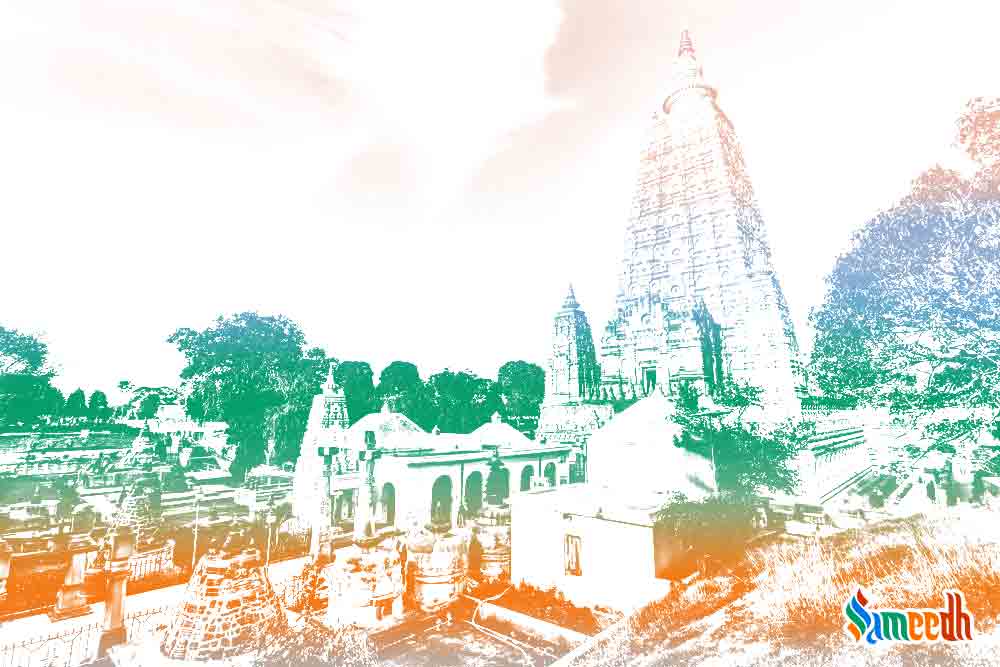Gaya, a place rich in culture and religion is the second largest city in Bihar, 100km from Patna. It is considered a sacred place for seeking spiritual blessings, salvation, and the well-being of departed souls.

LOCATION
Located 116 kms from Patna, Gaya is the second largest city in Bihar, a North Indian state. It is surrounded by a rocky mountainous region and a river – the Phalgu river. It is the headquarters city for the district of Gaya.
MYTHOLOGY
- Gayasur and Lord Vishnu: In Hindu mythology, it is said that Gaya was originally known as Gayasur, a demon who possessed immense power and had become a threat to the gods. To save the universe from his tyranny, Lord Vishnu is said to have defeated and killed Gayasur, transforming him into the holy site of Gaya. Thus, Gaya is considered a place of salvation and liberation.
- Pind Daan: Gaya is renowned as a major destination for performing the ritual of Pind Daan, also known as Shraddha. Numerous Finding mentions in the Great Epics that in the Ramayana, Gaya is where the last funeral rites of Dashrath, Ram’s father, were performed. This has led to devotees still coming to Gaya to perform the last rites of their loved ones. It is an important ceremony where Hindus offer oblations to their deceased ancestors to attain peace for their souls. The belief is that performing Pind Daan in Gaya ensures the salvation of ancestors and frees them from the cycle of birth and death.
- Vishnupad Temple: The Vishnupad Temple in Gaya is a significant pilgrimage site for Hindus. It is believed to be the spot where Lord Vishnu’s footprints are imprinted on a rock. The temple attracts devotees who come to seek blessings and offer prayers to Lord Vishnu. The footprints are considered sacred and worshipped as a symbol of divine presence.
- Akshayabat: Gaya is also home to a sacred banyan tree called Akshayabat, which is believed to be an immortal tree that grants eternal life. Devotees often visit this tree to seek blessings, perform rituals, and offer prayers. It is considered highly auspicious and holds a special place in Hindu mythology.
- Pitru Paksha: Gaya witnesses a massive influx of devotees during the period of Pitru Paksha, which is a 16-day period in the Hindu calendar dedicated to honoring ancestors. During this time, people visit Gaya to perform rituals and offer prayers for the peace and salvation of their ancestors’ souls.
- Gautam Buddha Enlightenment: Gautam Buddha attained enlightenment in Bodh Gaya, due to which Gaya is now a city sacred for the Buddhist community. It is also considered holy for Hindus and Jains.
SIGNIFICANCE
During the early 19th century, Gaya was divided into two parts, one sacred and one secular. The All-India Kisaan Sabha established an ashram at Gaya, which was a hub of the freedom struggle in Bihar. Gaya was also the location of a meeting of the Indian National Congress, which was attended by many prominent congressmen such as Gandhi, Sardar Patel and Rajendra Prasad.
The Mahabodhi Temple Complex is listed as a World Heritage Site by UNESCO. The Phalgu River and Vishnupad (The foot of Vishnu) are also places of significance to Hindus.
ARCHITECTURE
The Stupa at Bodh Gaya is an architectural marvel. It was built in 250 BC by Ashoka The Great in memory of his father, King Mahinda. The Stupa was not built in one go, additions were made by different kingdoms. The structure, built on three acres of land, has a mound 4 metres tall. Some brick structures were later dug up and recovered from the area surrounding the Stupa.
PLACE DURING DIFFERENT TIME PERIEODS
Gaya was the location for rise and fall of many empires and was especially at the peak of its splendour during the Maurya Empire. This was a time of Buddhism. When the Gupta Dynasty took over, with Samudragupta as their leader, during the 4th century CE, Hinduism peaked. Gaya became part of the Pala Empire during 750 CE, during which the temple at Bodh Gaya is said to have been built. It was invaded by the Mughals during the12 century BC after which it stayed under their rule until the British Raj, after which it gained independence with the rest of the nation.
ARCHAEOLOGY
In 1930, 225 bronze sculptures were excavated from Kurkihar, a village close to Gaya. These sculptures, seemingly of Buddhist origin, date back to the 9th century. The artifacts have several inscriptions, some of Buddhist and some of Hindu origin.
DEMOGRAPHY
According to the 2011 population census, Gaya has a total population of 470,839, a literacy rate of 85.74% and a sex ratio of 986 women for every 1000 men.
To read more about such interesting places and to know more about the vibrant culture of our nation, read more blog posts from Sameedh
